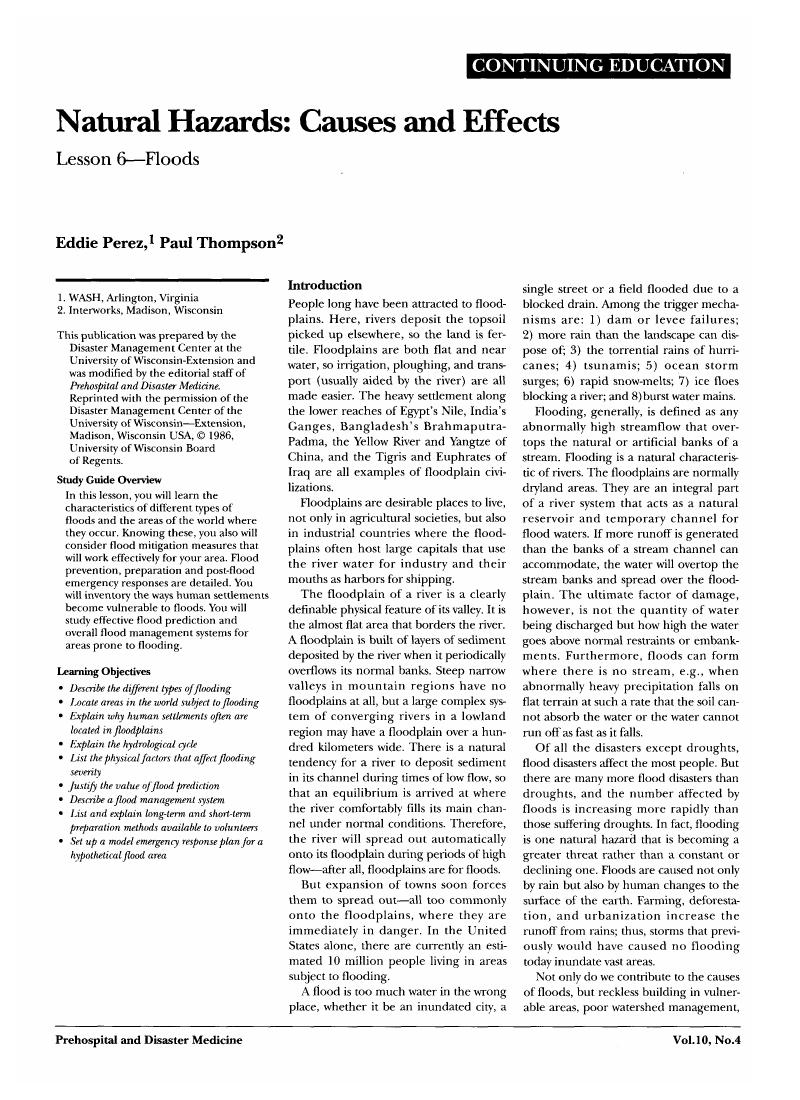No CrossRef data available.
Article contents
Natural Hazards: Causes and Effects: Lesson 6—Floods
Published online by Cambridge University Press: 28 June 2012
Abstract
An abstract is not available for this content so a preview has been provided. Please use the Get access link above for information on how to access this content.

- Type
- Continuing Education
- Information
- Copyright
- Copyright © World Association for Disaster and Emergency Medicine 1995
References
References
1. INTERTECT: The Potential Contribution of Peace Corps to Disaster Preparedness in Africa. Dallas, Texas: INTERTECT, 1983, p 80.Google Scholar
2. Anten, JGF, Franken, S: The Pattern of Famine in Bangladesh. Amsterdam, Netherlands, p 144.Google Scholar
3. Funaro-Curtis, R: Natural Disasters and the Development Process. Washington, D.C.: OFDA/AID, July 1982, pp 13–14.Google Scholar
4. Waltham, T: Catastrophy, The Violent Earth. New York City, N.Y.: Crown Publishers, 1978, pp 84–86.Google Scholar
5. Clark, C, the Editors of Time-Life Books: Planet Earth. Alexandria, Va.: Time-Life Books, 1982, p 24.Google Scholar
6. INTERTECT: The Potential Contribution of Peace Corps to Disaster Preparedness in Africa. Dallas, Texas: INTERTECT, 1983, pp 80–82.Google Scholar
7. UNDRO: Disaster Preiiention and Mitigation: A Compendium of Current Knowledge, Vol. 2, Hydrological Aspects, 1978, p 8.Google Scholar
8. Robinove, CJ: The Role of Remote Sensing and Satellite Monitoring System in Hydrologic Hazard Management. Reston, Va.: U.S. Department of the Interior Geological Survey Proceedings of the Geologic and Hydrologic Hazards Training Program, U.S. Geological Survey, 1984, pp 899–902.Google Scholar
9. National Science Foundation: A Report on Flood Hazard Mitigation. Washington, D.C.: National Science Foundation, 1980, p 27.Google Scholar
10. National Science Foundation: A Report on Flood Hazard Mitigation. Washington, D.C.: National Science Foundation, 1980, p 17.Google Scholar
11. INTERTECT: The Potential Contribution of Peace Corps to Disaster Preparedness in Africa. Dallas, Texas: INTERTECT, 1983, pp 83–84.Google Scholar
12. DeGroot, WG, Tucker, LS, Urbonas, B: Elements of a Comprehensive Floodplain Management Program, Proceedings of the Geologic and Hydrologic Hazards Training Program. Reston, Va.: AID Office of Foreign Disaster Assistance and U.S. Geological Survey, 1984, an adaption; pp 943–959.Google Scholar
Bibliography
Clark, C, Editors of Time-Life Books: Planet Earth: Flood. Alexandria, Va.:Time-Life Books, 1982.Google Scholar
DeGroot, WG, Tucker, LS, Urbonas, B: Elements of a Comprehensive Floodplain Management Program, Proceedings of the Geologic and Hydrologic Hazards Training Program. Reston, Va.: AID Office of Foreign Disaster Assistance and U.S. Geological Survey, 1984, pp 943959.Google Scholar
Funaro-Curtis, R: Natural Disasters and the Development Process, Prepared for OFDA/AID, Washington, D.C., July 1982.Google Scholar
INTERTECT: The Potential Contribution of Peace Corps to Disaster Preparedness in Africa. Dallas, Texas: INTERTECT, 1983.Google Scholar
National Science Foundation: A Report on Flood Hazard Mitigation. Washington, D.C.: National Science Foundation, 1980.Google Scholar
Robinove, CJ: The Role of Remote Sensing and Satellite Monitoring Systems in Hydrologic Hazard Management. In: U.S. Department of the Interior Geological Survey Proceedings of the Geologic and Hydrologic Hazards Training Program, U.S. Geological Survey, Reston, Va., 1984.Google Scholar
UNDRO: Disaster Prevention and Mitigation: A Compendium of Current Knowledge, Vol. 2, Hydrological Aspects, 1978.Google Scholar
Waltham, T: Catastrophe, The Violent Earth. New York City, N.Y.: Crown Publishers, 1978.Google Scholar
White, G (Ed): Natural Hazards, Local, National Global, New York: Oxford University Press, 1974.Google Scholar


